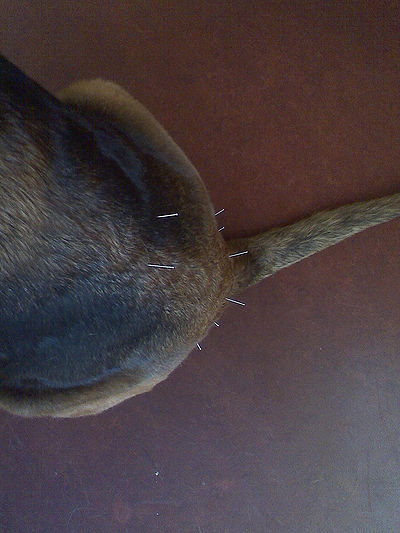The literal translation of Pyoderma is “pus in the skin.” Deep Pyoderma is a serious bacterial infection caused by staphylococcus bacteria or even e-coli. Pyoderma can be a Surface skin infection, Superficial which is an infection within the skin or Deep Pyoderma which is an infection under the skin. Symptoms of Pyoderma are rash, pain, […]
Dog Diseases
There are a number of diseases dogs are prone to and I’ll talk about some of them here. I’ll also try to include specific breeds of dog that are prone to certain illnesses and diseases.
I would advise you to be aware of your dog’s normal behavior. Signs of illness can be lack of appetite, decreased activity, weakness, not drinking much, not grooming, bad breath, sleeping more than usual, drooling, vomiting, diarrhea, coughing, trouble breathing, frequent and/or bloody urination. If your dog exhibits any of these symptoms or any behavioral changes and you are unsure of what to do, seek the advice of your veterinarian.
Things you need to know:
The normal color of a dog’s gums is pink. Pale, white, blue or yellow gums, contact your vet at once.
Normal temperature for a dog is 100-102.5 degrees Fahrenheit. Less than 99 degrees or over 104 degrees, contact your vet immediately.
A dog’s heart rate slows and speeds with each breath. This is not abnormal. You can check the heart rate by finding the femoral artery inside the back leg. Small dogs and puppies heart rate is 120-160 beats per minute. Dogs that are about 30 lbs. have a rate of 60-120 beats per minute. The larger the dog, the slower the heart rate.
A dog’s normal respiration rate is 10-30 breaths per minute. Panting can be up to 200 pants per minute.
To check if your dog is breathing, hold a tissue or mirror up to his nose. If there is movement or breath on the mirror, your dog is breathing, but get him to the vet immediately.
Problem signs are using the abdominals to breathe, gasping, loud noises, shallow breaths, difficulty exhaling. Call your vet immediately.
If you have any questions, I’ll be happy to answer them.
Note: Many new pet owners do not know about the availability of pet health insurance. Insurance for your dog is a great safety net to have for unforeseeable emergencies or illnesses. It is also helpful in covering routine shots and exams. Some plans start at just five dollars a month. To compare pet insurance plans in your area check out the link above.

Cats, Dogs and Hemorrhoids
Hemorrhoids in cats is usually an inherited problem. There can be other causes such as obesity, lack of enough fiber in the diet and not drinking enough water on a daily basis. Hemorrhoids are blood vessels that swell and appear as growths at the anal area. Cats often become constipated and then strain to relieve […]

Canine Distemper
Canine Distemper is a serious viral disease that is highly contagious to domestic dogs and wild canids. It spreads through respiratory secretions of an infected dog. Owners of puppies who have not had the entire series of vaccinations should use caution with exposure to other dogs and when outdoors to relieve themselves. First signs of […]

Canine Hydrocephalus
Canine Hydrocephalus is generally a hereditary condition. It can be congenital, meaning a pup is born with it. Brain injuries, infections, tumors, poison can also cause hydrocephalus. The word Hydrocephalus is from the Greek – hydro meaning water and cephalus concerning the head – hence the expression, water in the head. Hydrocephalus is the accumulation […]

French Heartworm
There are several types of worms that can infect our pets. Angiostrongylus vasorum known also as lungworm and French heartworm is a parasite that can live and infect the pulmonary arteries and right ventricle of the heart of wild and domestic canines – wolves, foxes, coyotes and dogs. It was discovered in Toulouse, France in […]

Military Dogs and PTSD
Military dogs go through a rigorous training period and play an undisputed role helping the armed forces in many ways. Unfortunately not only do our soldiers suffer post traumatic stress disorders, but combat can do the same to our 4-legged friends. Still a fairly new concept, it’s estimated that more than 5% of military dogs […]

Parainfluenza
Parainfluenza is a contagious viral disease affecting the respiratory tract. Dogs infected with the mild form can have a nasal discharge and either a moist cough or a dry cough which is similar to Bordetella (Kennel Cough). The Parainfluenza virus is part of the trio that make up Kennel Cough. The other two are adenovirus […]
MRSA in Pets
MRSA has found its way from humans to pets. Methicillin Resistant Staphylococcus Aureus (MRSA) has been reported in dogs but no cases have appeared in cats. This aggressive form, found in hospitals is a particular risk to dogs who undergo amputation of a leg. Living with Tripawds Tripawds immune systems are generally compromised. Staphylococcus bacteria […]

Hip Dysplasia
Hip Dysplasia occurs when there is a problem with the joining of the hip bone. The hip joint is a ball and socket and attaches the hind legs to the body of the dog. The ball is the femur head and the socket (acetabulum) is part of the pelvis. For ease of movement, the ball […]

